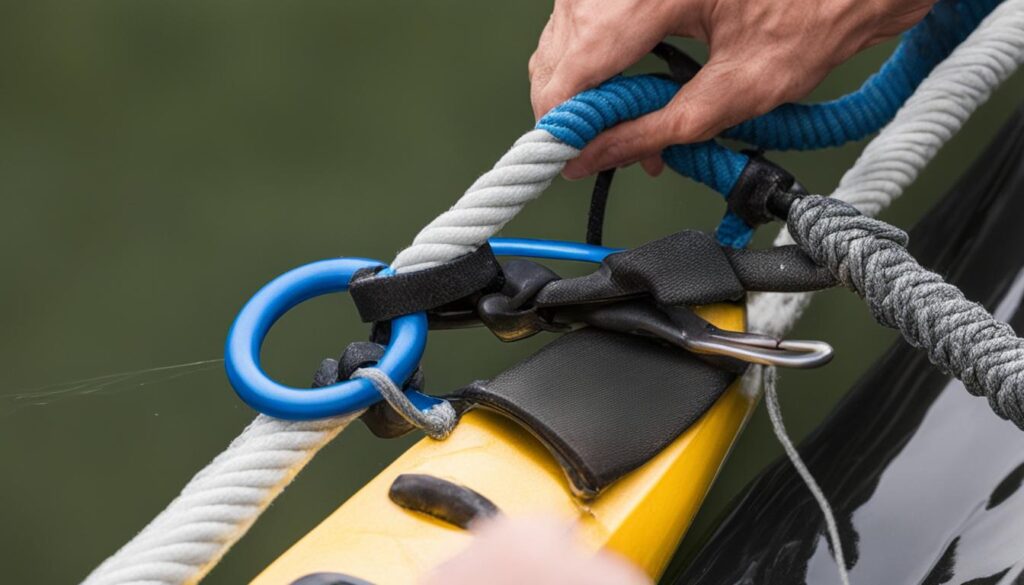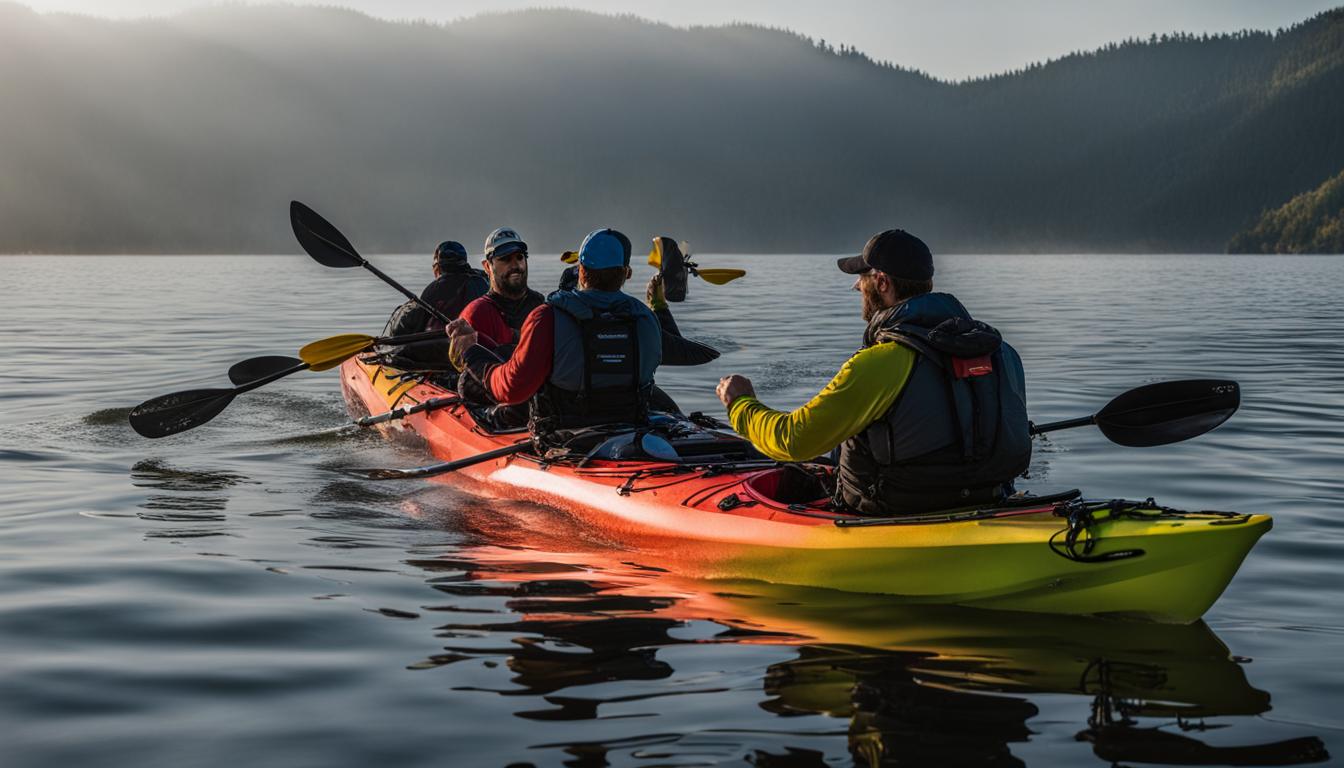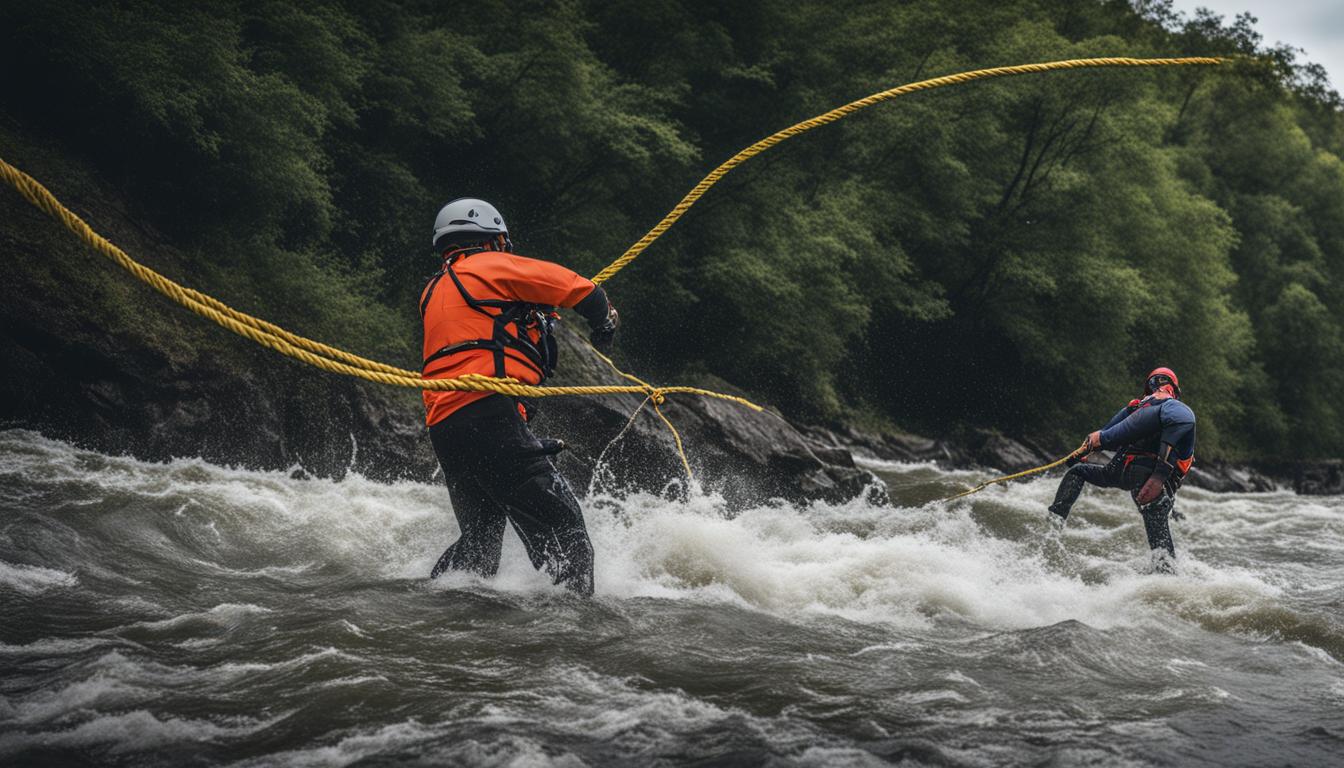Kayak fishing is a thrilling and rewarding outdoor activity that allows you to explore the waters while enjoying the thrill of reeling in your catch. To make the most of your kayak fishing experience, it’s important to have an efficient anchor system in place. Anchoring not only keeps you in one spot but also allows you to focus on fishing without being carried away by currents or wind.
Choosing the right anchor for your kayak fishing adventures is key to ensuring a successful and enjoyable trip. With various anchor types available, each suited for different fishing conditions, it’s essential to understand their differences and how to properly attach them to your kayak.
Key Takeaways:
- Choosing the right anchor is crucial for efficient kayak fishing.
- Types of kayak fishing anchors include folding grapnel anchors, bruce/claw anchors, stakeout poles, and drift anchors.
- Properly attaching the anchor to your kayak is important for stability and ease of use.
- Consider using an anchor trolley system for better maneuverability.
- Practice deploying and retrieving the anchor in controlled conditions before venturing into challenging waters.
Types of Anchors for Kayak Fishing
When it comes to kayak fishing, having the right anchor is essential for keeping your kayak stable and in place while you focus on reeling in the big catch. There are several types of anchors commonly used by kayak anglers, each with its own advantages depending on the fishing conditions.
Folding Grapnel Anchor: This anchor is a popular choice for calm and protected waters. Its folding design makes it convenient for storage, and it is less prone to snagging upon retrieval. The folding grapnel anchor provides good holding power and is highly versatile.
Bruce/Claw Anchor: If you’re fishing in areas with strong currents and little to no wind protection, the bruce/claw anchor is the go-to choice. It has excellent holding power and provides a reliable hold even in challenging conditions.
Stakeout Pole: The stakeout pole is ideal for fishing in shallow waters, both in saltwater and freshwater applications. It allows you to anchor your kayak without the need for heavy equipment, making it convenient and easy to use.
Drift Anchor: When it comes to open bodies of water where you want to control the rate at which you drift, a drift anchor is the way to go. It allows you to slow down your drift and stay in specific areas where you believe the fish are biting.

Choosing the right anchor type for your kayak fishing adventures depends on the conditions you’ll be fishing in. Consider factors such as water depth, current strength, wind, and the size of your kayak. By understanding the characteristics of each anchor type and their suitability for different conditions, you can ensure a more efficient and enjoyable kayak fishing experience.
Attaching the Anchor to Your Kayak
Once you have chosen the right anchor for your kayak fishing needs, the next step is to securely attach it to your kayak. There are a few different methods you can use to ensure your anchor stays in place while you focus on reeling in the big catch.
Anchor Cleat
An anchor cleat is a popular and reliable option for attaching your anchor to your kayak. This device is typically mounted on the side or deck of your kayak and provides a secure point to fasten the anchor line. To use an anchor cleat, simply feed the anchor line through the cleat and tie it off using a secure knot, such as a cleat hitch or bowline.
Anchor Trolley System
The anchor trolley system is another effective method for attaching your anchor to your kayak. This system consists of a pulley system that runs along the side of your kayak, allowing you to adjust the position of your anchor line depending on wind and current conditions. By using an anchor trolley system, you can easily change the direction that your kayak is facing, ensuring that you remain in the optimal fishing position at all times.
Anchor Float Leash
In situations where you may need to quickly retrieve your anchor, it is helpful to use an anchor float leash. This attachment consists of a buoyant float that is connected to your anchor line. If you need to give chase to a big fish or move to a new fishing spot, the anchor float leash will prevent your anchor from sinking out of reach and make it easier to retrieve when you’re ready to move.
When attaching your anchor to your kayak, it is important to ensure that the connection is secure and that the anchor is easily accessible. Always double-check your attachment method before heading out on the water to avoid any unexpected issues while out fishing.

| Attachment Method | Pros | Cons |
|---|---|---|
| Anchor Cleat | Secure and reliable attachment method | Requires installation on your kayak |
| Anchor Trolley System | Allows for easy adjustment of anchor position | Requires installation of pulley system |
| Anchor Float Leash | Prevents anchor from sinking out of reach | May cause slight drag in the water |
Tips for Using Anchor Systems in Kayak Fishing
When it comes to using anchor systems in kayak fishing, there are a few tips that can help you make the most of your fishing experience. First and foremost, it is important to choose the right anchor type for the specific conditions you will be fishing in. Different anchor types, such as folding grapnel anchors, bruce/claw anchors, stakeout poles, and drift anchors, are designed for different types of waters and fishing scenarios.
Before heading out into more challenging waters, it is crucial to practice deploying and retrieving the anchor in controlled conditions. This will help you become familiar with the process and ensure that you can confidently anchor your kayak when needed. Additionally, experimenting with different anchoring techniques can help you find the most effective approach for your fishing style.
Another tip for using anchor systems in kayak fishing is to take advantage of an anchor trolley system. This system allows you to adjust the position of your kayak based on wind and current, giving you more control over your fishing spot. By utilizing an anchor trolley system, you can easily face upwind or downwind, optimizing your fishing experience.
Lastly, always keep safety in mind when using anchor systems in kayak fishing. Make sure to secure the anchor line properly to your kayak and use an anchor float leash to ensure quick retrieval, especially in situations where you may need to give chase to a big fish. By following these tips, you can enhance the efficiency and effectiveness of your anchor system, allowing you to focus on what you love most – catching fish!
Table: Types of Anchors for Kayak Fishing
| Anchor Type | Best Used in | Advantages |
|---|---|---|
| Folding Grapnel Anchor | Calmer, protected waters | Less prone to snagging, easy to store |
| Bruce/Claw Anchor | Areas with strong currents and little wind protection | Provides excellent hold in challenging conditions |
| Stakeout Pole | Shallow waters | Can be used in both saltwater and freshwater |
| Drift Anchor | Open bodies of water | Controls drifting speed |
Conclusion
Anchoring is an essential aspect of kayak fishing, providing stability and allowing you to focus on your fishing efforts. By choosing the right anchor system for your kayak, you can maximize your efficiency and enhance your overall fishing experience.
Whether you opt for a folding grapnel anchor, a bruce/claw anchor, a stakeout pole, or a drift anchor, understanding the characteristics of each type is crucial. Each anchor is designed to excel in specific conditions, so consider the environment you’ll be fishing in and select accordingly.
Properly attaching your anchor to your kayak is also key. You can use an anchor cleat to secure the anchor line or opt for an anchor trolley system, which offers greater adjustability in response to wind and current. Don’t forget to include an anchor float leash to make retrieval quick and hassle-free.
Remember to practice deploying and retrieving your anchor in controlled conditions before taking on more challenging waters. Experiment with different anchoring techniques to find what works best for you. With an efficient anchor system in place, you can focus on what you love most—catching fish while enjoying the tranquility of kayak fishing.
FAQ
What types of anchors are commonly used in kayak fishing?
The folding grapnel anchor, bruce/claw anchor, stakeout pole, and drift anchor are commonly used in kayak fishing.
Which anchor is suitable for calm, protected waters?
The folding grapnel anchor is a popular choice for calm, protected waters.
What anchor is preferred for areas with strong currents?
The bruce/claw anchor is preferred for areas with strong currents.
What is a stakeout pole used for?
Stakeout poles are ideal for fishing shallow waters in both saltwater and freshwater applications.
What are drift anchors used for?
Drift anchors are used to control the rate at which you drift in open bodies of water.
How can I attach the anchor to my kayak?
You can attach the anchor to your kayak using an anchor cleat or an anchor trolley system.
What is an anchor trolley system?
An anchor trolley system is a pulley system that allows you to fully adjust the position of your kayak depending on wind and current.
How can an anchor float leash be helpful?
An anchor float leash can help you retrieve your anchor quickly, especially in situations where you need to give chase to a big fish.
What should I consider when choosing the right anchor?
You should consider the characteristics of the body of water you will be fishing in to choose the right anchor type.
How can I optimize my fishing experience with an anchor trolley system?
Using an anchor trolley system allows you to adjust the position of your kayak, optimizing your fishing experience.
What should I do before heading out into challenging waters?
Practice deploying and retrieving the anchor in controlled conditions to ensure you are prepared for challenging waters.
What does efficient use of anchor systems in kayak fishing require?
Efficient use of anchor systems in kayak fishing requires finding the right anchor that suits your needs and properly attaching it to your kayak.





